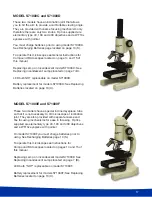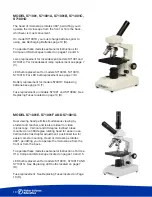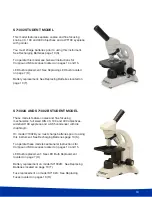
5
• IRIS DIAPHRAGM
: Iris Diaphragm, opening and closing of iris is controlled by lever. It is
designed to help achieve optimum resolution of the objective lens. Larger apertures used for
higher magnifications, and smaller apertures used for lower magnifications.
• MAGNIFICATION
: Total magnification obtained with each objective lens is determined by
multiplying the magnification of the eyepiece times the magnification of the objective. Keep
in mind that as magnification increases, field of view (area of the specimen seen when looking
through microscope) decreases.
• MECHANICAL STAGE
: Permits precise, mechanical manipulation of the specimen slide.
• MECHANICAL TUBE LENGTH
: Distance between the top of eyepiece tube to mounting face of
nosepiece. (On more advanced models, above elementary type, the tube length is 160mm).
• NEUTRAL DENSITY FILTER
: Neutral colored frosted filter designed to soften illumination hot
spots.
• NUMERICAL APERTURE (NA)
: Mathematical formula devised by Ernst Abbe for the direct
comparison of objective lens to resolving power.
• NOSEPIECE (REVOLVING TURRET)
: Designed to hold objective lenses permitting changes of
magnification by rotating different powered objective lenses into optical path. Forward facing
position used on elementary and high school models. Reverse facing nosepiece position used on
more advanced models permits easier access to stage when positioning specimen slides.
• OBJECTIVE LENS
: Lens closest to the object being viewed, forms first image of the specimen.
• OIL IMMERSION LENS
: High power (100x) objective lens which requires a medium of immersion
oil between the lens and the slide
• RESOLVING POWER
: Ability of the optical system to distinguish and separate fine structural
details in a specimen. The resolving power is limited by the NA of the objective, and it also
depends upon the working NA of the sub-stage condenser, the higher the effective NA of the
system the greater will be the resolving power.
• RHEOSTAT
: Variable potentiometer that adjusts the light intensity of the illuminator.
• SEIDENTOPF BINOCULAR HEAD
: Seidentopf heads remain parfocality when changing
interpupillary distances and are supplied with one adjustable diopter adjustment to adjust image
for any difference in vision between left and right eyes.
• SPECIMEN SLIDE
: Typically a 3 by 1 inch by 1mm thick glass with a specimen held for
observation covered by a .01mm thick cover glass.
• STAGE CLIPS
: Two locked-on clips hold specimen slide in place on stage.
• STAGE
: Platform of the microscope where the specimen slide is placed.
• SAFETY RACK STOP
: Prevents higher power objectives from breaking specimen slides, and
prevents damage to objective lens. Stop has been pre-adjusted at the factory.
• TENSION ADJUSTMENT COLLAR
: The tension collar is used to adjust and control “body tube”
or “stage” drift (Instrument not remaining in focus).
• TRANSMITTED ILLUMINATION
: Used to illumination both compound and stereo microscopes
providing illumination from below specimen.
• WORKING DISTANCE
: Distance between the top of specimen slide and the front of the objective
lens.






































